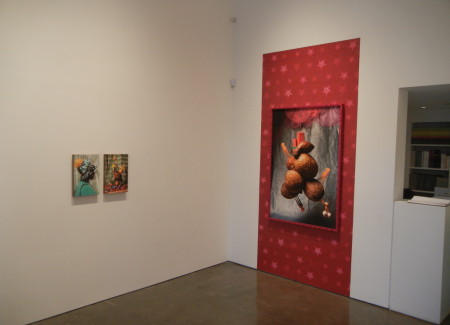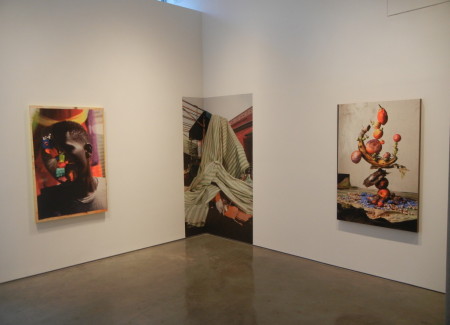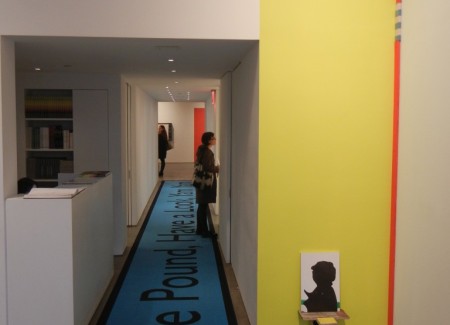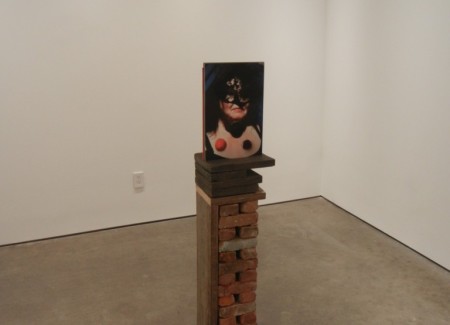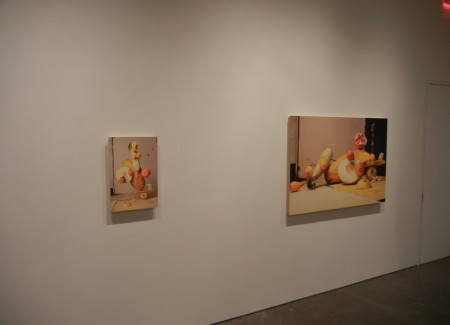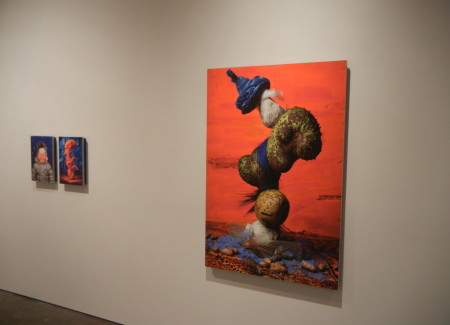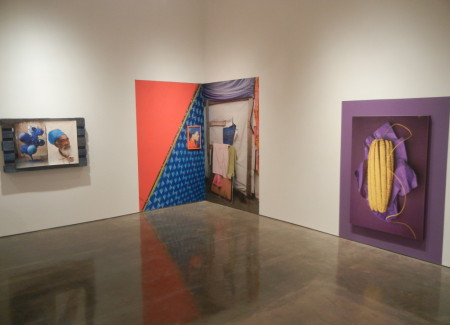JTF (just the facts): A total of 26 color photographic works, displayed unmatted in artist designed frames, and hung against white walls in the two main gallery spaces, the smaller side room, the alcove, and the hallway. All of the works are giclee prints on Hahnemuhle bamboo paper, made in 2013 or 2014. Physical sizes range from roughly 8×8 (round) to 59×39 (or reverse), and the works are available in editions of 3, 5, or 7 (+2AP). Several of the prints have been made more three dimensional via the addition of wood, bricks, and other materials, and the show also includes 4 images printed on vinyl and affixed directly to the walls, 1 carpet, and 1 large sculptural installation. A monograph of this body of work was published by Self Publish Be Happy in 2013 (now in a second edition, here). (Installation shots below.)
Comments/Context: Lorenzo Vitturi’s Dalston Anatomy was certainly one of the most talked about photobooks of 2013, its dazzling energy and vibrant colors seducing readers from all over the world. I too was enthralled by Vitturi’s joyfully sculptural assemblages and cultural combinations, and my review of the original photobook (here) is perhaps the best place to restart an ongoing discussion of the work. It covers some of the background on the Ridley Road Market in London, and it provides some initial thoughts on Vitturi’s extension of photography into the realm of sculpture with his vertiginous still life towers of exotic fruits, vegetables, and found objects, and his reconsiderations of street portraiture via rephotographed chalk dust interruptions.
In making his US solo debut, Vitturi’s real challenge was of course to translate the contagious effervescence of the successful photobook into the stark empty space of a white cube gallery – part of what makes the book so wonderful is its evocations of the sights, sounds, and smells found in the market; its patterned African fabric covers, large text snippets of conversation, and carefully controlled pairings of color vicariously envelop us in the cacophonous experience. The exciting news is that Vitturi has generally succeeded in breaking the tyranny of the cool gallery environment, turning his show into a site specific installation that disregards the generally accepted norms of a photography exhibit and seems altogether comfortable with laughter and conversation in the place of serious hushed whispers.
While Vitturi’s nearly tumbling piles of yams and plantains, melons and coconuts, snails and plastic balloons would likely keep us entertained on their own, his meticulous arrangement and installation of the images here goes far beyond a simple parade of eye level pictures. Images are resized into various shapes and forms (round, elliptical, rectangular) and reduced/enlarged, running the spectrum from small and intimate to large and physical; the changing scale creates movement and rhythm, a backward and forward dance in the gallery space. Each print is then displayed in a custom frame, combining layers of complementary or matching color, exposed plywood, and sometimes other materials (bricks, wooden pallets etc.), bringing the peripheral physical touch and brightness of the market back into the photographs; even larger vinyl images provide further context, or add background texture and pattern to the rooms. A long carpet runs the length of the connecting hallway, introducing the singsong sales pitch of “one pound, have a look, yam yam” into the silence of the gallery. And a massive sculptural installation dominates the back space, its assembled contents (a plastic garbage can, the ubiquitous green striped tarping, a wig, etc.) having been scavenged from both London and New York. Seen together, the setting is richly electric, the photographs forming the backbone of the overall multi-ethnic experience.
Photographically, Vitturi’s images stand up well to the increased scrutiny of the gallery setting. His bright colors pop off the wall (especially at large scale), the nearly collapsing constellations of eclectic, evocative items referencing the traditions of the still life while pulsating with mashed up cultural references and meanings; they feel fresh and alive rather than stuffed and tired. His interventionist portraits, with colored chalk dusk obscuring faces, also fare well at increased scale, turning market goers and stall owners into anonymous forms or exercises in compositional disruption.
What comes through best in this show is Vitturi’s experimental side; the original photobook is undeniably innovative in many ways, but in the gallery setting, his willingness to extend photography into three dimensions is given fuller release. Pictures become platforms, and objects, and physical things, the still lifes and portraits allowed to push out, drawing us into layers of ideas and references. As we might have expected, this show delivers a jovial sensory outburst; what’s perhaps more surprising is just how sophisticated and far reaching Vitturi’s underlying aesthetic logic turns out to be.
Collector’s POV: The works in this show are priced between $2600 and $12000, generally based on size, without the custom artist-designed frames and sculptural additions (which can be included for an additional fee). Vitturi’s work has not yet reached the secondary markets, so gallery retail remains the best option for those collectors interested in following up.

